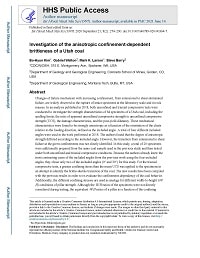Mining Publication: Investigation of the Anisotropic Confinement-dependent Brittleness of a Utah Coal
Original creation date: April 2021
Authors: B Kim, G Walton, M Larson, S Berry
Changes of failure mechanism with increasing confinement, from extensional to shear-dominated failure, are widely observed in the rupture of intact specimens at the laboratory scale and in rock masses. In an analysis published in 2018, both unconfined and triaxial compressive tests were conducted to investigate the strength characteristics of 84 specimens of a Utah coal, including the spalling limits, the ratio of apparent unconfined compressive strength to unconfined compressive strength (UCS), the damage characteristics, and the post-yield dilatancy. These mechanical characteristics were found to be strongly anisotropic as a function of the orientation of the cleats relative to the loading direction, defined as the included angle. A total of four different included angles were used in the work performed in 2018. The authors found that the degree of anisotropic strength differed according to the included angle. However, the transition from extensional to shear failure at the given confinements was not clearly identified. In this study, a total of 20 specimens were additionally prepared from the same coal sample used in the previous study and then tested under both unconfined and triaxial compressive conditions. Because the authors already knew the most contrasting cases of the included angles from the previous work using the four included angles, they chose only two of the included angles (0° and 30°) for this study. For the triaxial compressive tests, a greater confining stress than the mean UCS was applied to the specimens in an attempt to identify the brittle-ductile transition of the coal. The new results have been compiled with the previous results in order to re-evaluate the confinement-dependency of the coal behavior. Additionally, the different confining stresses are used as analogs for different width-to-height (W/H) conditions of pillar strength. Although the W/H ratios of the specimens were not directly considered during testing, the equivalent W/H ratios of a pillar as a function of the confining stresses were estimated using an existing empirical solution. According to this relationship, the W/H at which in situ pillar behavior would be expected to transition from brittle to ductile is identified.

- An Analysis of Flexural Strength and Crack Width for Fiber-Reinforced Shotcrete Used in Weak Rock Mines
- Anchorage Pull Testing for Fully Grouted Roof Bolts
- Cleat in Bituminous Coalbeds
- Correlation of Sonic Travel Time to the Uniaxial Compressive Strength of U.S. Coal Measure Rocks
- Diagnosing and Controlling Moisture-Sensitive Roof in Coal Mines
- Effects of Specimen Age on the Uniaxial Compressive Strength and Moisture Content of Weak Coal Measure Rocks
- Field Performance Testing of Fully Grouted Roof Bolts
- In Situ Estimation of Roof Rock Strength using Sonic Logging
- Neural Network Technology for Strata Strength Characterization
- Use of Surface Joint and Photolinear Data for Predicting Subsurface Coal Cleat Orientation